Mexican Tattoo Ideas are vibrant expressions of culture, heritage, spirituality, and tradition. These tattoos often fuse Aztec and Maya in mythology, religious symbols, family pride, and national icons in bold and meaningful art. Designs such as Chinese skull, la Katrina, The Virgin of Gwdalup, Eagles, Sombros, Day of the Dead Imagery, and Aztec Warriors pay tribute to the rich history and deep symbols of Mexico.
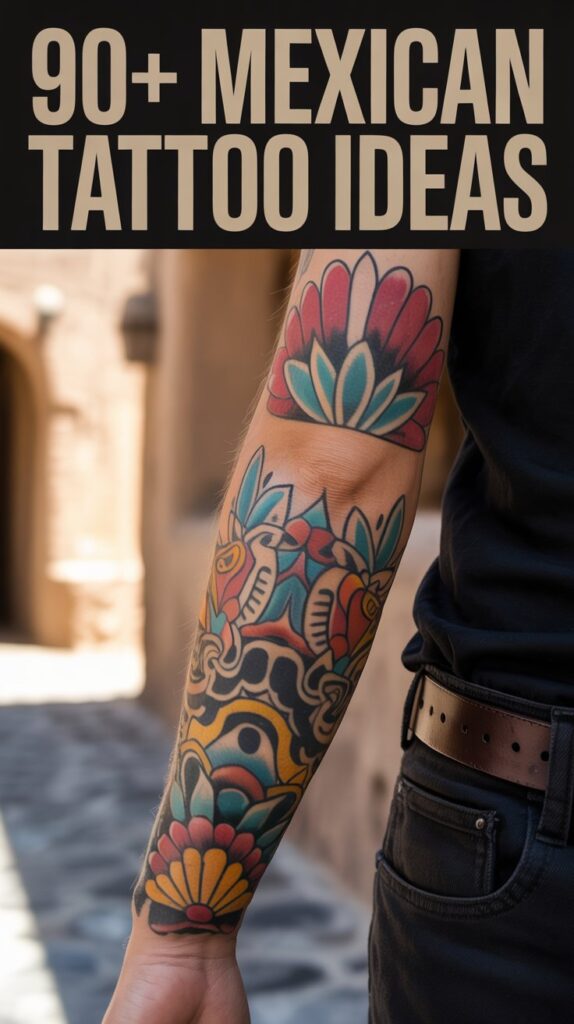
Popular styles have a combination of emotions with stories of cultural stories, from black and gray realism to colorful chico art. For many people, these tattoos serve as a tribute to the lineage, which symbolizes the reflection of spiritual beliefs, or strength, identity, and resistance. Whether it is an ornate Aztec calendar, a fierce Jaguar warrior, or a garland-hearted heart, every tattoo tells a personal and cultural story. Mexican tattoos are not just decorative – they are visual poems, a unique, striking, and deep exploration of the roots in love, loss, festive, and relationships.
Mexican Tattoo Ideas
- Sugar skull (Calavera)
- La Catrina portrait
- Aztec calendar stone
- Virgin of Guadalupe
- Mexican eagle and snake (national emblem)
- Aztec warrior helmet
- Sombrero with roses
- Mayan glyphs
- Día de los Muertos skull with candles
- Chicano-style praying hands
- Mariachi skeleton playing guitar
- Mexican flag with smoke effect
- Frida Kahlo portrait
- Aztec serpent god Quetzalcoatl
- Taco or chili pepper cartoon
- Sacred Heart with thorns
- Mexican revolutionaries (Pancho Villa)
- Rosary wrapped around a cross
- Lucha libre mask
- Mayan sun god symbol
- Mexican lady with skull makeup
- Cactus with sombrero
- Lowrider car in Chicano style
- Skull with marigold flowers
- Aztec pyramid with sun rays
- Mayan jaguar warrior
- Zapatista hat and rifle
- Mexican lotería card tattoos
- Old-school “Mi Familia” script
- Chili pepper with flames
- Traditional papel picado
- Charro cowboy on horseback
- Tequila bottle and lime
- Ornamental Aztec border
- Huitzilopochtli (Aztec god of war)
- Fiesta-themed sleeve
- Mayan calendar glyphs
- Mexican street food icons
- Virgin Mary with roses
- Sugar skull with monarch butterflies
- El Santo lucha libre tribute
- Maracas with floral accents
- Milagro heart (folk-style)
- Dia de los Muertos full sleeve
- Skeleton mariachi band
- Woman with half-skull face
- Lowrider bike with roses
- Piñata with skull features
- Aztec eagle warrior
- Frida Kahlo with unibrow and flowers
- Mexican blanket patterns
- Mezcal bottle with agave
- Mexican coat of arms
- Spanish prayer text
- A skeleton couple dancing
- Chicano-style female face
- Broken heart with roses
- Traditional lucha ring ropes
- Cempasúchil flower tattoo
- Mayan death god
- Sun and moon, Aztec duality
- Family name in Aztec font
- Papel picado banner with skulls
- Rosary around a Mexican flag
- Taco cartoon with “Viva México”
- Mayan temple scene
- Day of the Dead altar
- Eagle wings spreading over shoulders
- Mexican woman with rose crown
- Aztec blood sacrifice symbol
- Tattooed skull in a suit
- Virgin Mary’s hand on her chest
- Milagro cross
- Tenochtitlán ruins scene
- “La Vida Loca” script
- Ornamental Aztec symbols down the spine
- Dia de los Muertos couple kissing
- Chihuahua with sombrero
- Mexican snake wrapping around the arm
- Zapata’s mustache with a hat
- Mayan sun across the back
- Quetzal bird in flight
- Prayer hands holding a sombrero
- Face-painted child for Día de los Muertos
- Bloodline roots from the map of Mexico
- Skull with rosary in teeth
- Tribal cactus sleeve
- Aztec god face on chest
- Classic “Mexican Pride” banner
- Mexican guitar with flowers
- Lucha mask with roses and flames
- Half skull, half Frida Kahlo portrait
- Golden eagle claw tattoo
Contents
1. Chinese Skull (Calvera)
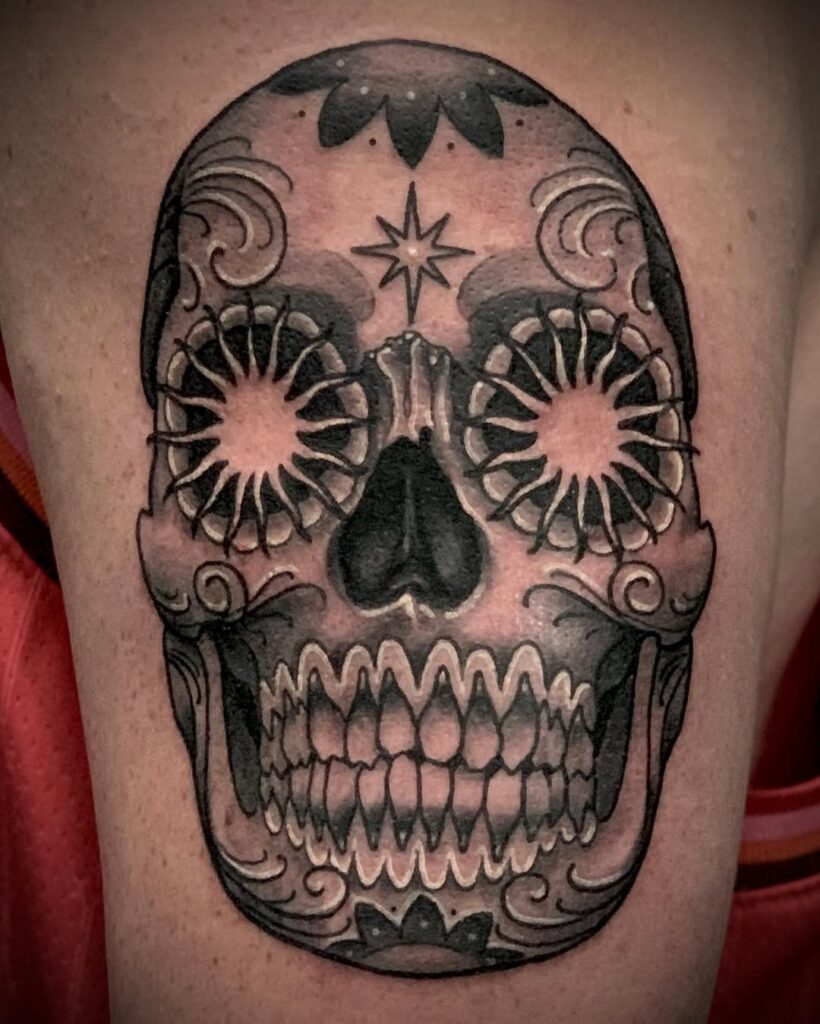
- Step 1 – Represents honoring the dead, often seen during Día de Los Muertos.
- Step 2 – Symbol of joyful remembrance rather than sorrow.
- Step 3 – Often decorated with flowers, candles, or loved ones.
- Step 4 – The objective is to keep the souls of ancestors alive and celebrate.
2. La Katrina portrait
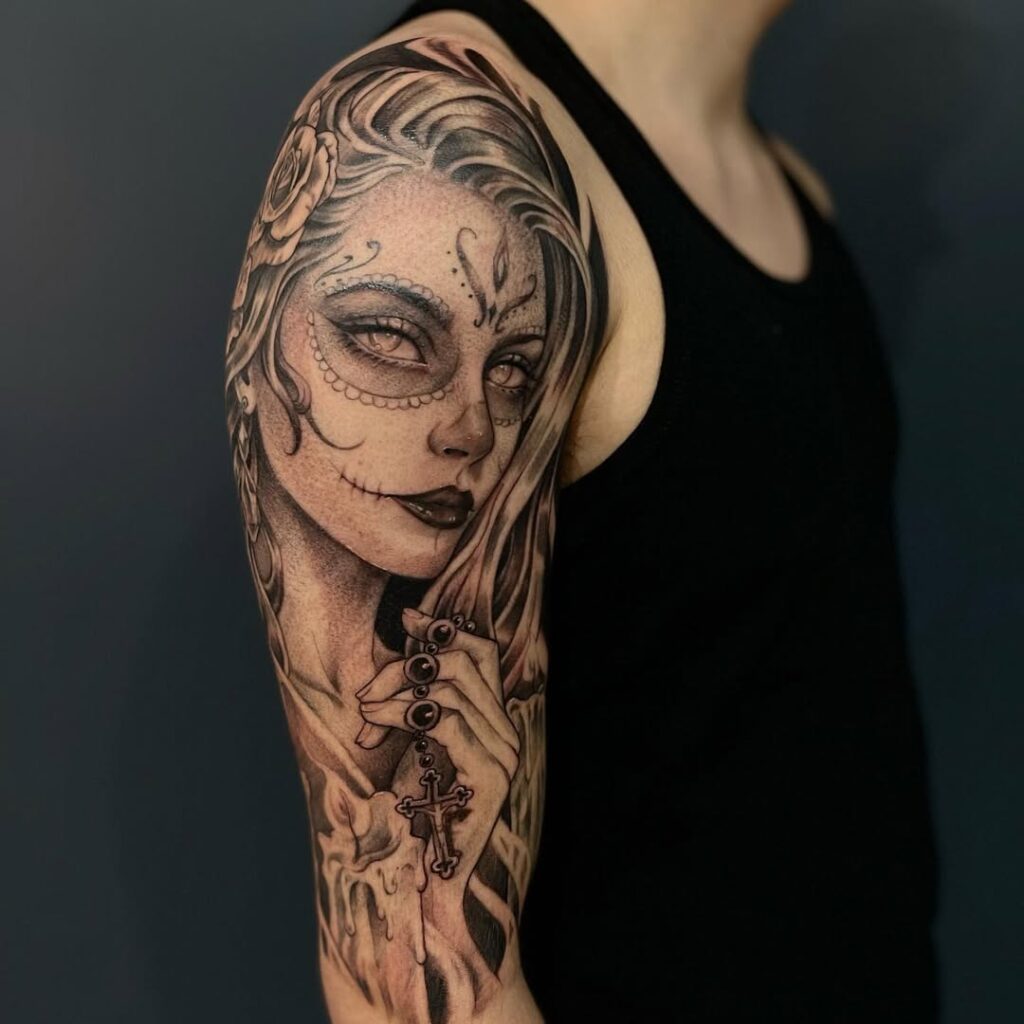
- Step 1 – Jose Gwadalupay, based on an elegant female skeleton from Posada.
- Step 2 – Criticism reminds us all of the similarities between pride and class, and death.
- Step 3 – Represents both cultural pride and artistic rebellion.
- Step 4 – The objective symbolizes mortality and inheritance.
3. Aztec Calendar Stone
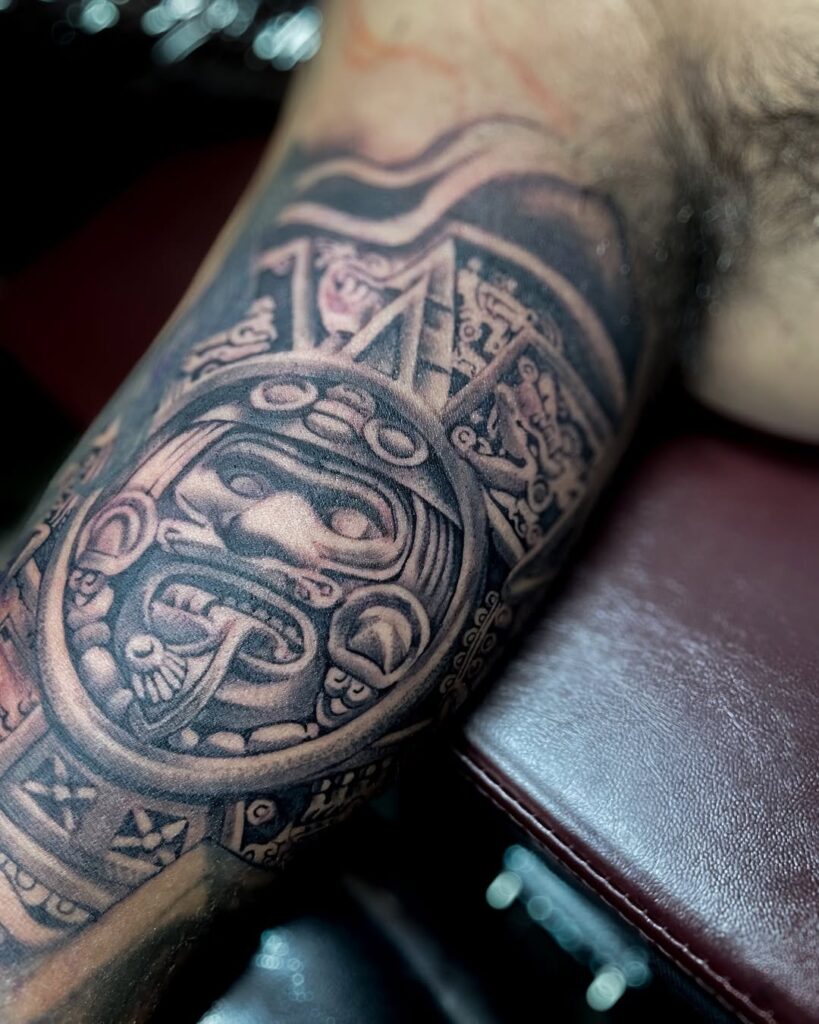
- Step 1 – Represents the passage of time and cosmic order.
- Step 2 – Aztec has a mythological meaning rich in culture.
- Step 3 – A powerful symbol of Mexican recognition and lineage.
- Step 4 – The objective is to connect with ancient roots and spiritual cycles.
4. Virgin of Kudalup
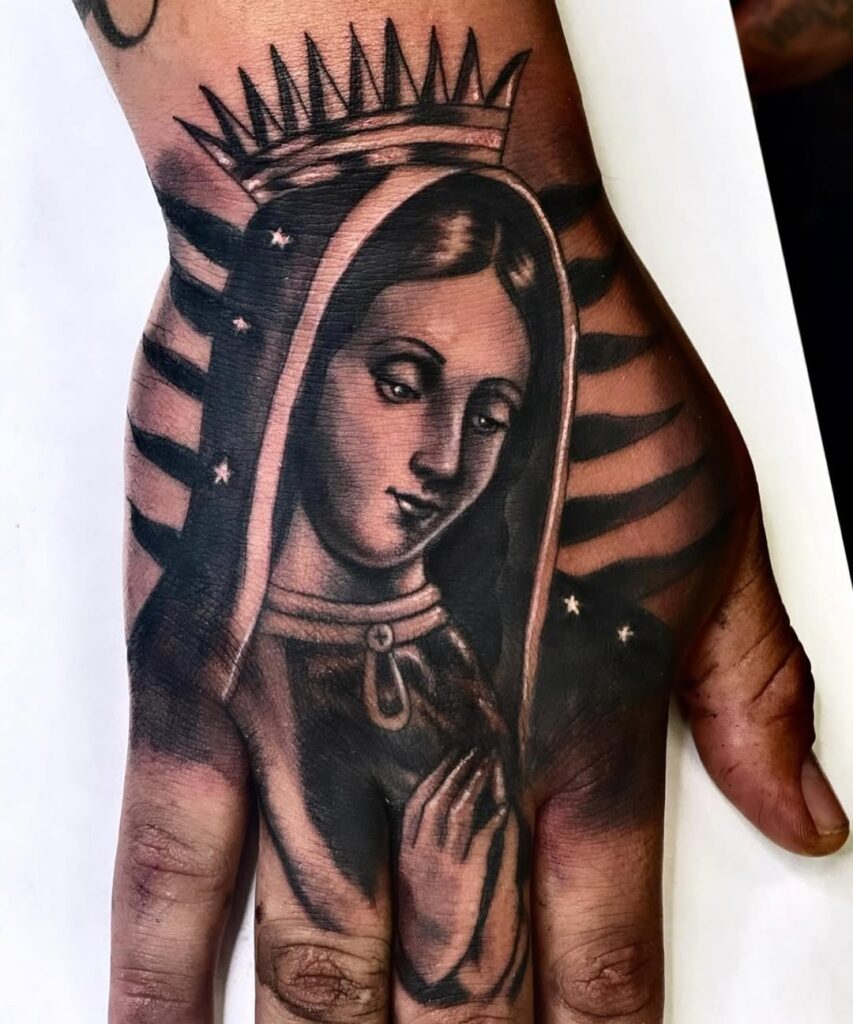
- Step 1 – She symbolizes the spiritual mother and divine protection of Mexico.
- Step 2 – Represents faith, hope, and flexibility in the Catholic tradition.
- Step 3 – A sacred person for Mexican families and personal beliefs.
- Step 4: The Objective is guidance, treatment, and cultural devotion.
5. Mexican eagle and snake (national symbol)
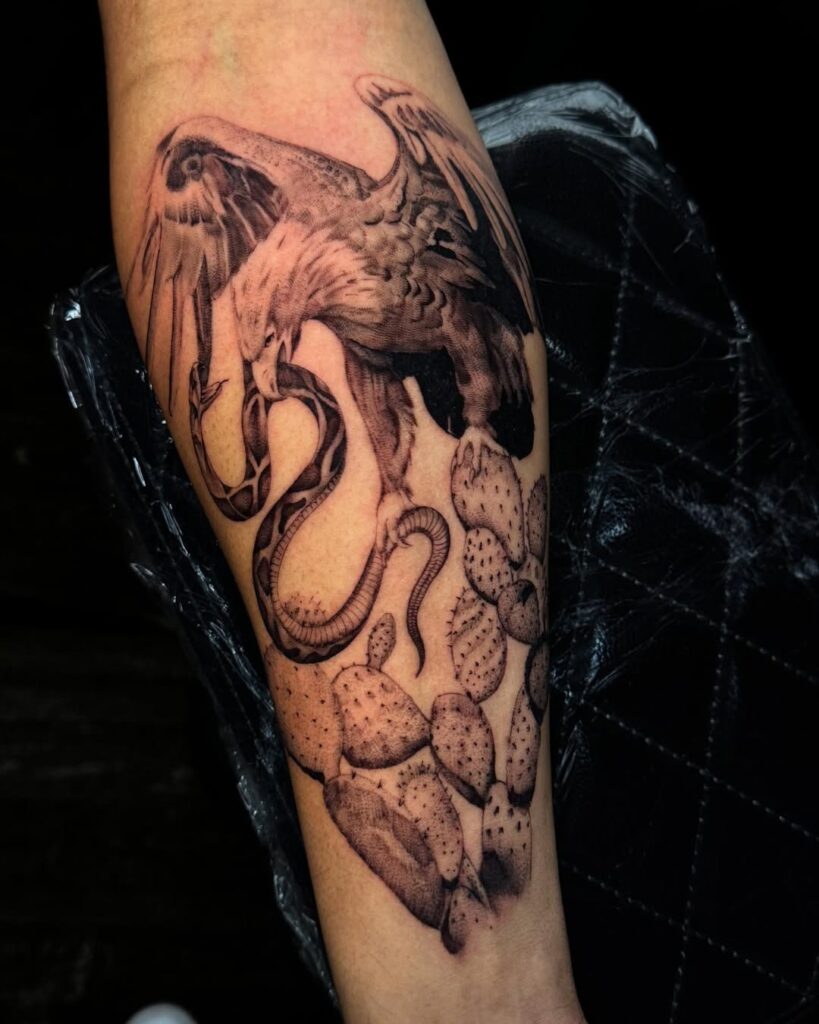
- Step 1 – A prediction comes from the Aztec Legend of Tenochtitlan.
- Step 2 – Shakti is a symbol of freedom and national pride.
- Step 3 – Snake represents challenges; Eagle, win them.
- Step 4 – The objective is to embrace the legacy of Mexico and the spirit of power.

Welcome to StylishTattooIdeas.com! I’m Brittany Lauzon — a passionate tattoo artist based in sunny Florida with a deep love for the art of self-expression through ink.
With years of experience designing and creating meaningful tattoos for clients of all backgrounds, I’ve learned that every tattoo has a story. That’s why I created this blog — to share detailed, stylish, and creative tattoo ideas that help you find inspiration, clarity, and confidence before getting inked.
Whether you’re thinking about your very first tattoo or you’re planning your next masterpiece, I offer carefully curated ideas, style guides, placement tips, and symbolic meanings for all types of tattoos — big or small, bold or delicate.
